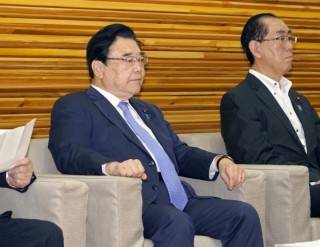Loading
Search
▼ Japan Has Better Chance Of Seeing End To Deflation, Government Says
- Category:Other
Amid recent strong wage growth and broadening price hikes, Japan stands a better chance of finally breaking with the deflation that has "shackled" the nation for a quarter of a century, the government said Tuesday in its annual economic and fiscal policy report.
The government has yet to formally declare an end to deflation because current rising prices are largely due to higher import costs and there is still uncertainty over the sustainability of wage growth, a key factor in determining whether deflation is a thing of the past.
But while such cost-push factors, rather than strong consumer appetite, may have been driving up inflation in recent months and increasing the burden on households, they are also changing people's price expectations, according to the white paper presented to a Cabinet meeting on Tuesday.
"We should not overlook the fact that Japan has an opportunity to emerge from deflation, given that recent price gains have served as a trigger for consumer inflation expectations to heighten and for prices, which were pegged to zero, to rise," the report said.
For deflation to officially end, Japan must judge there is no prospect of returning to a situation in which prices continuously fall.
The government said it must coordinate closely with the Bank of Japan and guide economic policy by carefully examining macroeconomic conditions.
"It is necessary to ensure an end to deflation by dispelling the deep-rooted deflationary mindset (among consumers) and boosting growth expectations."
Japan's inflation rate has already hit its highest level in over four decades and has stayed above the BOJ's 2% target for more than a year. But the government and the central bank expect inflation to slow in coming months as the effects of high import costs fade.
Companies have been relatively quick to pass on surging import costs of raw materials to consumers, but service prices have been more or less flat. Economists are keeping tabs on whether price hikes will further spread in the services sector.
The government has yet to formally declare an end to deflation because current rising prices are largely due to higher import costs and there is still uncertainty over the sustainability of wage growth, a key factor in determining whether deflation is a thing of the past.
But while such cost-push factors, rather than strong consumer appetite, may have been driving up inflation in recent months and increasing the burden on households, they are also changing people's price expectations, according to the white paper presented to a Cabinet meeting on Tuesday.
"We should not overlook the fact that Japan has an opportunity to emerge from deflation, given that recent price gains have served as a trigger for consumer inflation expectations to heighten and for prices, which were pegged to zero, to rise," the report said.
For deflation to officially end, Japan must judge there is no prospect of returning to a situation in which prices continuously fall.
The government said it must coordinate closely with the Bank of Japan and guide economic policy by carefully examining macroeconomic conditions.
"It is necessary to ensure an end to deflation by dispelling the deep-rooted deflationary mindset (among consumers) and boosting growth expectations."
Japan's inflation rate has already hit its highest level in over four decades and has stayed above the BOJ's 2% target for more than a year. But the government and the central bank expect inflation to slow in coming months as the effects of high import costs fade.
Companies have been relatively quick to pass on surging import costs of raw materials to consumers, but service prices have been more or less flat. Economists are keeping tabs on whether price hikes will further spread in the services sector.
The BOJ, meanwhile, is bracing for upside risks to the inflation outlook and has already tweaked its monetary policy by loosening its grip on long-term government bond yields, which tend to rise when economic conditions improve.
Accelerating inflation is a headache for households, with real wages continuously falling despite the annual pay negotiations between management and labor unions for the fiscal year that began in April turning out to be the best in about three decades.
As the economy recovers from the COVID-19 pandemic supported by pent-up demand for services, the spotlight has been increasingly on labor shortages in sectors hit hard by the pandemic.
The white paper noted that Japan has entered a phase in which wages can rise easily due to tight labor market conditions. It also underlined the need to improve labor productivity, teach members of the workforce new skills and facilitate job-hopping for better pay and working conditions.
Financial worries, especially among younger generations, are seen as part of the reason why Japan has been struggling to reverse the dwindling birthrate, and Prime Minister Fumio Kishida has vowed to boost the state budget for child care support drastically because now is the "last chance" to change the trend.
This comes as increased fiscal spending to support households and businesses during the pandemic and recent inflation have put fiscal restoration on the back burner. Japan's fiscal health is the worst among advanced economies, with debt more than twice the size of the economy.
"The government should put more focus on tackling the declining birthrate or spurring corporate investment over the mid- to longer-term than emergency spending to support people's livelihoods and stimulating demand," the document said.
The government is expected to extend its fuel subsidy program beyond this fall, while Kishida has unveiled plans to draw up a fresh economic package next month.
A total of ¥141 trillion was allocated to steps to cope with COVID-19 and inflation over the three years to fiscal 2022, of which ¥128 trillion was funded by government debt issuance.
The white paper raises the alarm about a recent rise in the issuance of short-term, one-year government bonds, in relation to longer ones. The BOJ already owns about half of the outstanding government debt as part of its aggressive monetary easing.
"When the percentage of short-term bonds increase, this will make (the nation) more directly impacted by bond price fluctuations caused by external factors," the white paper said. "The pace of increases in debt-servicing costs will also quicken."
- August 29, 2023
- Comment (0)
- Trackback(0)



